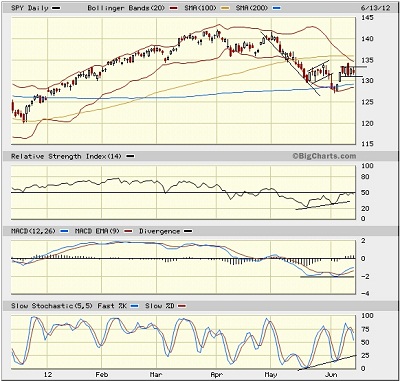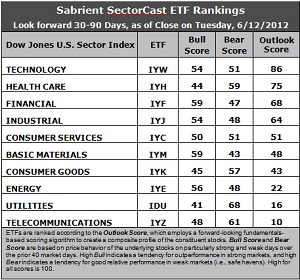Sector Detector: Market back in holding pattern
 During the month of May, the Dow Industrials managed only five positive days, but June has offered up some recovery so far. Despite the persistently negative news we are inundated with each day—creating real trepidation among investors—there are actually a lot of promising signs here in the U.S., and the technical picture seems to have entered a holding pattern as investors await signs of improving stability elsewhere.
During the month of May, the Dow Industrials managed only five positive days, but June has offered up some recovery so far. Despite the persistently negative news we are inundated with each day—creating real trepidation among investors—there are actually a lot of promising signs here in the U.S., and the technical picture seems to have entered a holding pattern as investors await signs of improving stability elsewhere.
To that end, European leaders launched a $125 billion bailout of Spanish banks. Obviously, bond rates in the latest hot spots like Spain and Italy need to come down, preferably below 6%, to achieve some stability. After all, Italy carries a ton of debt—only Japan and the U.S. carry a bigger load. Also, the ECB endorsed a plan for a banking union and a bank deposit guarantee program to calm investor fears about the safety of their deposits. We will likely witness even more programs rolling out as they seek to calm markets by demonstrating resolve.
If they are successful, given the mass exodus of equity investors from European stocks, we might be seeing a major buying opportunity forming in Europe. But let’s take one step at a time. For the moment, the big event is Greece’s new election this Sunday. At this point, anything is possible as both the far right and far left appear to have roughly equal support among the electorate.
SPY closed Wednesday at 132.07. It has entered a holding pattern for the past week, awaiting a catalyst to either break out or break down. The prior bear flag pattern shown was initially confirmed, but the 200-day simple moving average provided immediate support, and now SPY is churning smack dab between its 100-day and 200-day SMAs and between its upper and lower Bollinger Bands. RSI, MACD, and Slow Stochastic are giving few clues, even though last week they diverged from the price breakdown by forming higher lows.

A longer-term chart (over one year) shows that important support sits near 125. A breakdown below the 200-day SMA and the 125 level would not bode well. But bulls seem to be willing to put up a fight.
The TED spread (indicator of credit risk in the general economy, measuring the difference between the 3-month T-bill and 3-month LIBOR interest rates) closed Wednesday at 38 bps, holding the same level since mid-February. The VIX (CBOE Market Volatility Index—a.k.a. “fear gauge”) closed Wednesday at 24.27, up 10% on the day. It has been hanging around in the low 20’s for the past few weeks.
Latest rankings: The table ranks each of the ten U.S. industrial sector iShares (ETFs) by Sabrient’s proprietary Outlook Score, which employs a forward-looking, fundamentals-based, quantitative algorithm to create a bottom-up composite profile of the constituent stocks within the ETF. In addition, the table also shows Sabrient’s proprietary Bull Score and Bear Score for each ETF.
High Bull score indicates that stocks within the ETF have tended recently toward relative outperformance during particularly strong market periods, while a high Bearscore indicates that stocks within the ETF have tended to hold up relatively well during particularly weak market periods. Bull and Bear are backward-looking indicators of recent sentiment trend.
As a group, these three scores can be quite helpful for positioning a portfolio for a given set of anticipated market conditions.
Observations:

1. Technology (IYW) remains in the top spot with an Outlook score of 86 this week, followed by Healthcare (IYH) at 75. Industrial (IYJ) scores about the same as last week, but a resurgence in Financial (IYF) pushed it down to fourth. Still, the rankings reflect a bullish bias, with the more economically sensitive sectors like Technology, Financial, Industrial, and Consumer Services all in the top five and having an Outlook score above 50.
2. Utilities (IDU) and Telecom (IYZ) remain in the bottom two. IDU is saddled with the lowest long-term growth rate, and IYZ has the highest (worst) forward P/E. With Consumer Goods (IYK) in the bottom four, we see that defensive sectors bunched at the bottom. Also, stocks within Energy (IYE) continue to be downgraded by the analysts.
3. Looking at the Bull scores, Basic Materials (IYM) and Financial (IYF) have been quite strong on strong market days, scoring 59. Utilities (IDU) is by far the weakest on strong days, scoring 41.
4. Looking at the Bear scores, Utilities (IDU) remains the investor favorite “safe haven” on weak market days, scoring a strong 68, followed by Telecom (IYZ). Materials (IYM) has the lowest Bear score of 43. Stocks within IYM have tended to sell off the most when the market is pulling back.
5. Overall, IYW now shows the best all-weather combination of Outlook/Bull/Bear scores. Adding up the three scores gives a total of 191. IYZ is the worst at 119. IDU and IYZ might be sitting at the bottom of the Outlook rankings, but these two reflect the best combination of Bull/Bear at 109. Consumer Services (IYC) now displays the worst combination of Bull/Bear with a 101.
These scores represent the view that the Technology and Healthcare sectors may be relatively undervalued overall, while Telecom and Utilities sectors may be relatively overvalued based on our 1-3 month forward look.
Top-ranked stocks within Technology and Healthcare sectors include CalAmp (CAMP), Innodata (INOD), Questcor Pharmaceuticals (QCOR), and Auxilium Pharmaceuticals (AUXL).
Disclosure: Author has no positions in stocks or ETFs mentioned.
About SectorCast: Rankings are based on Sabrient’s SectorCast model, which builds a composite profile of each equity ETF based on bottom-up scoring of the constituent stocks. The Outlook Score employs a fundamentals-based multi-factor approach considering forward valuation, earnings growth prospects, Wall Street analysts’ consensus revisions, accounting practices, and various return ratios. It has tested to be highly predictive for identifying the best (most undervalued) and worst (most overvalued) sectors, with a one-month forward look.
Bull Score and Bear Score are based on the price behavior of the underlying stocks on particularly strong and weak days during the prior 40 market days. They reflect investor sentiment toward the stocks (on a relative basis) as either aggressive plays or safe havens. So, a high Bull score indicates that stocks within the ETF have tended recently toward relative outperformance during particularly strong market periods, while a high Bear score indicates that stocks within the ETF have tended to hold up relatively well during particularly weak market periods.
Thus, ETFs with high Bull scores generally perform better when the market is hot, ETFs with high Bear scores generally perform better when the market is weak, and ETFs with high Outlook scores generally perform well over time in various market conditions.
Of course, each ETF has a unique set of constituent stocks, so the sectors represented will score differently depending upon which set of ETFs is used. For Sector Detector, I use ten iShares ETFs representing the major U.S. business sectors.
About Trading Strategies: There are various ways to trade these rankings. First, you might run a sector rotation strategy in which you buy long the top 2-4 ETFs from SectorCast-ETF, rebalancing either on a fixed schedule (e.g., monthly or quarterly) or when the rankings change significantly. Another alternative is to enhance a position in the SPDR Trust exchange-traded fund (SPY) depending upon your market bias. If you are bullish on the broad market, you can go long the SPY and enhance it with additional long positions in the top-ranked sector ETFs. Conversely, if you are bearish and short (or buy puts on) the SPY, you could also consider shorting the two lowest-ranked sector ETFs to enhance your short bias.
However, if you prefer not to bet on market direction, you could try a market-neutral, long/short trade—that is, go long (or buy call options on) the top-ranked ETFs and short (or buy put options on) the lowest-ranked ETFs. And here’s a more aggressive strategy to consider: You might trade some of the highest and lowest ranked stocks from within those top and bottom-ranked ETFs, such as the ones I identify above.
